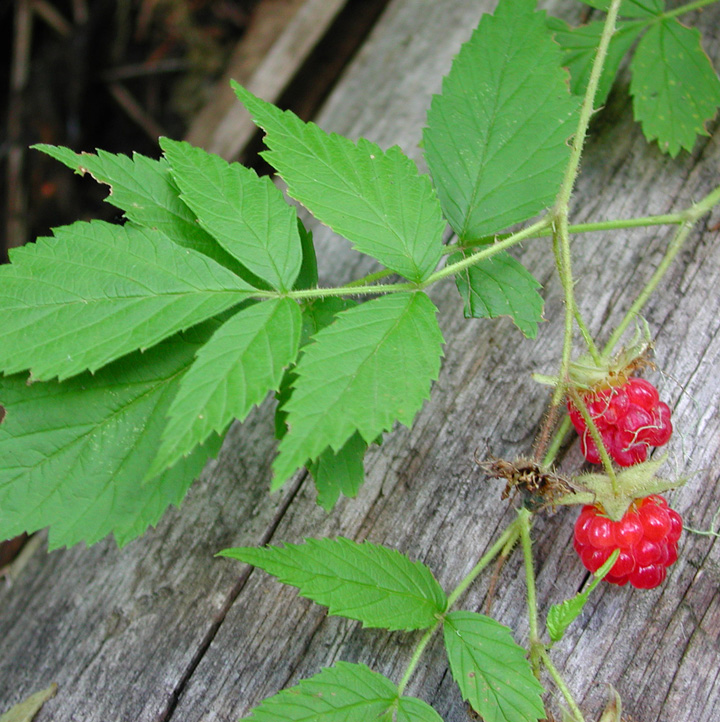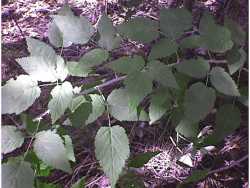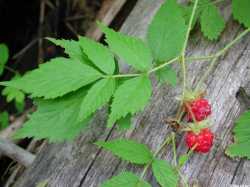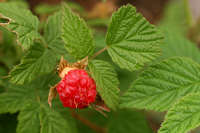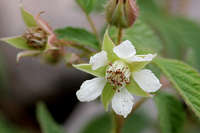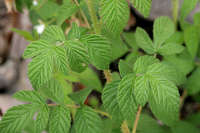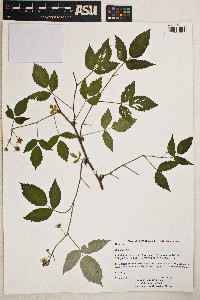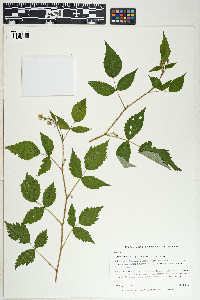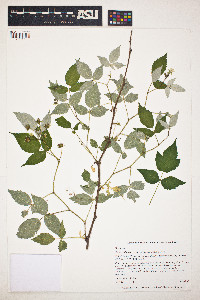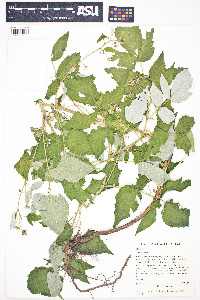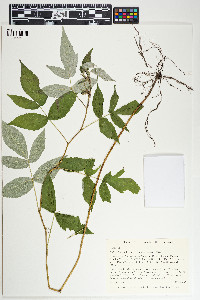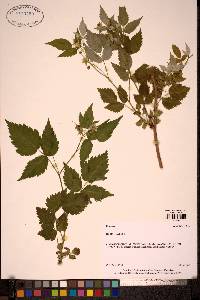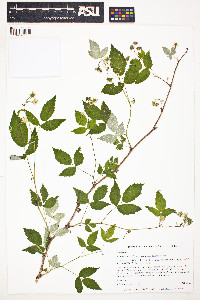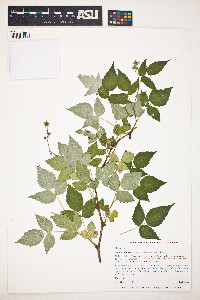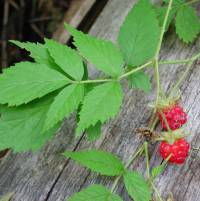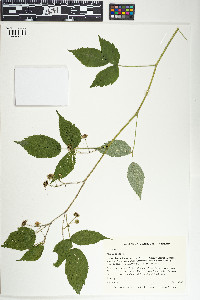|
|
|
|
Family: Rosaceae
American red raspberry, more...grayleaf red raspberry
|
Plant: woody shrub; Canes 1-2 m long, erect to decumbent; old epidermis of floricanes flaking off; plants in ours pubescent and glandular; prickles many, slender, narrow-based, terete or subterete, at most only moderately down-curved, often gland-tipped Leaves: deciduous, green above, gray to white below; leaflets usually lanceolate; margins irregularly serrate to doubly serrate, sometimes lobed; primocane leaves in ours 7-16 cm long, 5-15 cm wide, pinnately 3-9-foliolate; floricane leaves 2-8(-11) cm long, 2-7 cm wide, pinnately 3-5(-7)-foliolate INFLORESCENCE: simple obscurely bracteate cymes with 1-4 flowers terminating short side-branches of the floricane or in leaf axils, sometimes surpassing the leaves Flowers: sepals ascending, caudate, 4-12(-20) mm long, the main portion deltoid to narrowly lanceolate; ovaries tomentose; styles glabrous Fruit: large, tasty, spherical to sub-hemispherical, weakly coherent, separating from the torus; drupelets bright red, tomentulose, fleshy Misc: Pine, fir, and spruce forests often in wet or rocky places; 1850-3500 m (6000-11500 ft); (May-)Jun-Aug(-Sep) REFERENCES: Brasher, Jeffrey W. 2001. Rosaceae. J. Ariz. - Nev. Acad. Sci. Volume 33(1). Stems to 2 m, erect, spreading, or decumbent, sparsely to densely armed with slender-based prickles and stiff, glandular bristles; primocane lfls 3 or 5, ovate to lanceolate, acuminate, sharply serrate mostly above the middle, softly gray-pubescent beneath; intermediate pair of lfls, when present, inserted close to the terminal lfl; infl an umbelliform cyme of 2-5 fls, often also with 1 or 2 solitary fls from the upper axils; pedicels stipitate-glandular and ±bristly, the bristles exceeding the glandular hairs and gland-tipped when young; sep soon reflexed; pet white or greenish-white, spatulate to obovate, erect, shorter than the sep; fr red (yellow), 1-1.5 cm thick, separating as a unit from the persistent receptacle; 2n=14, seldom more. Dry or moist woods, fields, and roadsides; Nf. to Alas., s. to Pa., Ind., Io., and Ariz. May-July. The Amer. and e. Asian plants, as here described, constitute the var. strigosus (Michx.) Maxim., in contrast to the eglandular Eurasian var. idaeus, which is cult. in many cultivars. At the subspecific level our plants would be subsp. melanolasius Focke. (R. strigosus) Gleason, Henry A. & Cronquist, Arthur J. 1991. Manual of vascular plants of northeastern United States and adjacent Canada. lxxv + 910 pp. ©The New York Botanical Garden. All rights reserved. Used by permission. Common Name: western red raspberry Duration: Perennial Nativity: Native Lifeform: Shrub Wetland Status: None General: Deciduous shrub, 0.5-2 m (1.6-7 ft) tall; thicket forming; armed with slender, straight prickles and stalked glands; stems numerous, erect to decumbent, yellowish to yellowish brown, often with a delicate white bloom; epidermis exfoliating on older stems; vegetative reproduction through rhizomes and root suckers. Leaves: Alternate, pinnately compound, green and glabrous to somewhat hairy above, gray or white-tomentose below; first year (vegetative) stem leaves 3-9 foliate, 7-16 cm long, 5-15 cm wide; second year (reproductive) stem leaves 3-5 (7) foliate, 2-8 cm long, 2-7 cm wide; leaflets lanceolate, margins irregularly serrate to doubly serrate, occasionally lobed; stipules linear; petiole covered with many small hairs, stalked glands, and gland-tipped prickles. Flowers: Inflorescence a raceme or simple cyme, 1-4 flowered, arising from the leaf axils or terminating short axillary branches; sepals 5, 4-12 mm long, with slender prickles and stalked glands, acuminate or caudate at tip; petals 5, oblanceolate to spatulate, 5-7 mm long, white. Fruits: Aggregate of weakly connected drupelets, spherical, 1-1.2 cm wide, bright red at maturity, slightly tomentose. Ecology: Found in moist and rocky areas in ponderosa pine and high-elevation mixed conifer forests from 6,000-11,500 ft (1829-3505 m), flowers June-August. Distribution: Apache, Cochise, Coconino, Gila, Graham, Greenlee, Pima, and Yavapai counties; widely distributed across the northern hemisphere and throughout the cooler parts of North America. Notes: Only var. strigosus is present in Arizona. This is a shade-intolerant species with little forage value for most species, but the fruits are eaten by many birds and mammals. It also is useful for erosion control and soil stabilization. It can be propagated through cuttings, and most seeds require stratification and/or scarification for germination. Rubus idaeus requires periodic disturbance in order to maintain itself, and it will sprout readily or come back from the seed bank following fire. Ethnobotany: Berries are eaten fresh or dried and make tasty preserves. Roots and leaves are used to concoct an emetic, blood purifier, and urinary tract aid. Editor: Springer et al. 2011 |
|
|
|


